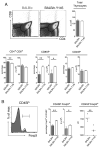Strength of TCR signal from self-peptide modulates autoreactive thymocyte deletion and Foxp3(+) Treg-cell formation
- PMID: 24307208
- PMCID: PMC3959276
- DOI: 10.1002/eji.201343767
Strength of TCR signal from self-peptide modulates autoreactive thymocyte deletion and Foxp3(+) Treg-cell formation
Abstract
Autoreactive CD4(+) CD8(-) (CD4SP) thymocytes can be subjected to deletion when they encounter self-peptide during their development, but they can also undergo selection to become CD4SPFoxp3(+) Treg cells. We have analyzed the relationship between these distinct developmental fates using mice in which signals transmitted by the TCR have been attenuated by mutation of a critical tyrosine residue of the adapter protein SLP-76. In mice containing polyclonal TCR repertoires, the mutation caused increased frequencies of CD4SPFoxp3(+) thymocytes. CD4SP thymocytes expressing TCR Vβ-chains that are subjected to deletion by endogenous retroviral superantigens were also present at increased frequencies, particularly among Foxp3(+) thymocytes. In transgenic mice in which CD4SP thymocytes expressing an autoreactive TCR undergo both deletion and Treg-cell formation in response to a defined self-peptide, SLP-76 mutation abrogated deletion of autoreactive CD4SP thymocytes. Notably, Foxp3(+) Treg-cell formation still occurred, albeit with a reduced efficiency, and the mutation was also associated with decreased Nur77 expression by the autoreactive CD4SP thymocytes. These studies provide evidence that the strength of the TCR signal can play a direct role in directing the extent of both thymocyte deletion and Treg-cell differentiation, and suggest that distinct TCR signaling thresholds and/or pathways can promote CD4SP thymocyte deletion versus Treg-cell formation.
Keywords: Immune regulation; Thymic selection; Tolerance.
© 2013 WILEY-VCH Verlag GmbH & Co. KGaA, Weinheim.
Conflict of interest statement
Figures






References
-
- Ashton-Rickardt PG, Bandeira A, Delaney JR, Van Kaer L, Pircher HP, Zinkernagel RM, Tonegawa S. Evidence for a differential avidity model of T cell selection in the thymus. Cell. 1994;76:651–663. - PubMed
-
- Sebzda E, Wallace VA, Mayer J, Yeung RS, Mak TW, Ohashi PS. Positive and negative thymocyte selection induced by different concentrations of a single peptide. Science. 1994;263:1615–1618. - PubMed
-
- Hogquist KA, Jameson SC, Heath WR, Howard JL, Bevan MJ, Carbone FR. T cell receptor antagonist peptides induce positive selection. Cell. 1994;76:17–27. - PubMed
-
- Starr TK, Jameson SC, Hogquist KA. Positive and negative selection of T cells. Annu Rev Immunol. 2003;21:139–176. - PubMed
-
- Sakaguchi S. Naturally arising CD4+ regulatory T cells for immunologic self-tolerance and negative control of immune responses. Annu Rev Immunol. 2004;22:531–562. - PubMed
Publication types
MeSH terms
Substances
Grants and funding
LinkOut - more resources
Full Text Sources
Other Literature Sources
Molecular Biology Databases
Research Materials

